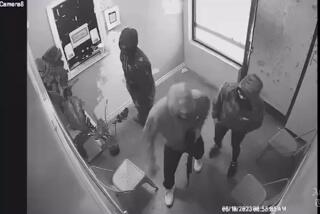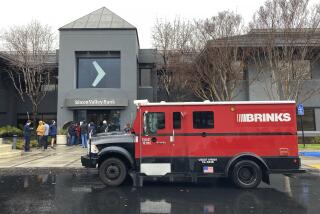Questions, Pain Linger Year After 3 Slayings : Violence: Investigations of the first night of last spring’s unrest have stalled. But relatives say the victims have not been forgotten.
- Share via
Edward Travens was a continuation school student, John Willers was an itinerant construction worker from Utah and Imad Sharaf a Jordanian immigrant with a job as a photo lab technician.
They could hardly have come from more disparate walks of life. But between April 29 and May 3, 1992, they came together in a grisly trinity.
The three were the San Fernando Valley’s slaying victims during last spring’s riots.
A year later, they share another thing in common--their cases are unsolved. Detectives and relatives of the victims say the investigations of all three deaths may have suffered from the civil disorder, particularly during the crucial few days immediately after the crimes.
“It’s a sad thing,” said Robert Ordelheide, the San Fernando police detective on the Travens case. “With the riots, there was just so much commotion going on.”
“Whatever happened, it didn’t get enough attention,” Yousef Sharaf said of his brother Imad’s case.
The Sharaf case is perhaps the most bizarre of the three--and the one that has come closest to being solved.
The body of Sharaf, 31, was found early on May 3, 1992, by firefighters answering a report of a brush fire near the on-ramp to the San Diego Freeway at San Fernando Mission Boulevard. According to police, the body had been doused with a flammable substance and set on fire.
At first, Sharaf, a Granada Hills resident who emigrated from Jordan three years ago, was listed as a riot victim. Detectives now believe that he was drugged some time before he was set ablaze and that the fire may have been an attempt to cover up the murder as riot-related.
“It was not riot-related, but it was at the right time,” LAPD Detective Tom King said. “Every crook in the city took advantage of the riots.”
After only three days of investigation, police arrested Sharaf’s roommate, Samiee Farzan, as a suspect, but the 31-year-old Iranian immigrant was released without being charged.
King said Farzan is still a suspect. “We feel we know who our suspect is,” he said. “We just don’t have the witnesses or corroboration. We need another piece of evidence.”
The identification of a suspect has provided little solace for Yousef Sharaf who, like relatives of the other Valley victims, has felt increasing frustration during the past year.
“I still don’t know what happened exactly,” he complained. “Why? Who? All I have are these questions without any answers.”
Sharaf said police told him his brother’s death may have involved a drug deal gone bad. But he added, “They didn’t show me anything to prove it had anything to do with drugs. I know he wasn’t involved in drugs,” Sharaf said of his brother.
King declined to discuss a possible motive for the murder.
Travens, 15, was also initially listed as a riot victim. The Mission Hills resident was shot dead on the evening of April 29--the first day of the riots--while driving to a San Fernando video store with his brother and a friend.
Police now believe the shooting was gang-related, rather than riot-related. Travens was shot by a gunman who approached his Cadillac, asked, “Where are you from?”--a query often used as a gang challenge--and then fired into the vehicle.
“It was one of those drive-bys that are so common in the San Fernando Valley now,” Ordelheide said.
Beyond the possible link to gangs, police do not have much to go on. Neither of the two passengers in Travens’ car was able to identify the gunman. There were no other eyewitnesses--according to Ordelheide, the streets of San Fernando were unusually empty that night as people stayed home because of the rioting elsewhere in Los Angeles.
“It’s a very difficult case because we don’t have the ability to even identify a suspect,” he said. “It’s a tough case, an extremely tough case.”
Ordelheide said his job was made even tougher by the relative lack of attention it received in its early days from the media, which was then consumed by coverage of the riots.
In a recent attempt to generate some leads, Travens’ mother posted flyers throughout the northeast Valley offering a $10,000 reward for information about the case.
“I went where all the gangs hang out, to all the projects,” Rosie Travens said. “I talked to some of the gang members.” But her efforts have so far been in vain and her frustration is mounting. Last Sunday, three of her late son’s friends painted a large portrait and mural with a religious theme on the wall of a building in San Fernando in memory of Edward.
“I’m really getting very discouraged. You have no idea how frustrating it is,” she said, adding, “I still don’t know what happened that night. My mind is a blank about that night.”
Willers, 36, was killed only two hours after Travens and at a location only two miles from the Travens crime scene. The tile-setter, who was working at a Mission Hills supermarket with his Salt Lake City-based construction crew, was gunned down outside the motel where he was staying on Sepulveda Boulevard.
The crew members had stayed up that night watching riot coverage on television. Around 10:45 p.m., they heard the sound of cars colliding outside the motel--the conclusion of a chase in which, according to police, three people in one car pursued two robbery suspects in another. The crash brought many of the motel guests out onto the street.
Willers stayed outside until the injured motorists were taken away by ambulance. According to co-workers, he returned to his room but decided to go back out half an hour later. Shots rang out and Willers was found dead in the middle of the street.
“He was caught up in the moment when the city was erupting,” said Detective Woodrow Parks of the LAPD’s Foothill Division. “It probably was a riot-related thing.”
At first, police were hopeful about cracking the case. Based on information from two witnesses who saw two teen-agers running from the area of the shooting, they released composite drawings of the suspects. But so far, Parks said, the investigation has yielded “absolutely nothing. . . . We never got responses from anybody recognizing them (the suspects).”
Both Parks and Ordelheide are now reduced to the detective’s last hopes--an unexpected tip from a witness or a call from someone who has been arrested for an unrelated crime and is willing to supply information as part of a deal.
“The only way you make a case like this is if somebody talks,” Ordelheide said. “Other than that, we have nothing.”
RELATED STORIES: B3
More to Read
Sign up for Essential California
The most important California stories and recommendations in your inbox every morning.
You may occasionally receive promotional content from the Los Angeles Times.










